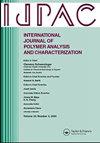Synthesis of decorated polyborosiloxane for enhancing the flame retardancy and mechanical property of epoxy resin
IF 1.7
4区 工程技术
Q4 POLYMER SCIENCE
International Journal of Polymer Analysis and Characterization
Pub Date : 2025-01-02
DOI:10.1080/1023666X.2024.2425720
引用次数: 0
Abstract
In this work, the decorated polyborosiloxane (MAPBS) with phosphorus-nitrogen components was first synthesized via a hydrolysis-condensation reaction and thus incorporated the MAPBS filler into epoxy resin (EP) to fabricate composites by a simple blending method. It could be found that the MAPBS with epoxy groups showed a good dispersion level in the EP matrix, endowing EP composites with superior flame retardancy and mechanical properties. Thanks to the combination of phosphorus-, nitrogen-, boron-, and silica-containing units in MAPBS filler, the addition of 6 wt% MAPBS made EP achieve significantly improved limiting oxygen index (25.2 ± 0.5%) and UL-94 rating (V1). Meanwhile, cone calorimeter test results revealed that the peak heat release rate (PHRR), total heat release (THR), and total smoke production (TSP) of the EP-MAPBS6 composite were reduced by 31%, 62%, and 67%, respectively, as compared to the pure EP. In addition, the MAPBS6 composite exhibited balanced tensile strength (105.1 MPa) and elongation at break (87.6%) among the prepared samples. The present work provides an effective strategy to fabricate EP composites with improved comprehensive performances.
用于增强环氧树脂阻燃性和力学性能的装饰型聚硼硅氧烷的合成
本文首先通过水解缩合反应合成了含磷氮组分的修饰型聚硼硅氧烷(MAPBS),并将MAPBS填料加入环氧树脂(EP)中,通过简单的共混法制备了复合材料。结果表明,环氧基MAPBS在EP基体中表现出良好的分散水平,使EP复合材料具有优异的阻燃性能和力学性能。由于MAPBS填料中含磷、含氮、含硼和含硅单元的组合,添加6 wt%的MAPBS可以显著提高EP的极限氧指数(25.2±0.5%)和UL-94等级(V1)。与此同时,锥量热计测试结果显示,EP- mapbs6复合材料的峰值放热率(PHRR)、总放热率(THR)和总产烟率(TSP)分别比纯EP降低了31%、62%和67%。此外,MAPBS6复合材料的抗拉强度为105.1 MPa,断裂伸长率为87.6%。本工作为制备综合性能更高的EP复合材料提供了一条有效的途径。
本文章由计算机程序翻译,如有差异,请以英文原文为准。
求助全文
约1分钟内获得全文
求助全文
来源期刊
CiteScore
3.50
自引率
5.30%
发文量
37
审稿时长
1.6 months
期刊介绍:
The scope of the journal is to publish original contributions and reviews on studies, methodologies, instrumentation, and applications involving the analysis and characterization of polymers and polymeric-based materials, including synthetic polymers, blends, composites, fibers, coatings, supramolecular structures, polysaccharides, and biopolymers. The Journal will accept papers and review articles on the following topics and research areas involving fundamental and applied studies of polymer analysis and characterization:
Characterization and analysis of new and existing polymers and polymeric-based materials.
Design and evaluation of analytical instrumentation and physical testing equipment.
Determination of molecular weight, size, conformation, branching, cross-linking, chemical structure, and sequence distribution.
Using separation, spectroscopic, and scattering techniques.
Surface characterization of polymeric materials.
Measurement of solution and bulk properties and behavior of polymers.
Studies involving structure-property-processing relationships, and polymer aging.
Analysis of oligomeric materials.
Analysis of polymer additives and decomposition products.

 求助内容:
求助内容: 应助结果提醒方式:
应助结果提醒方式:


